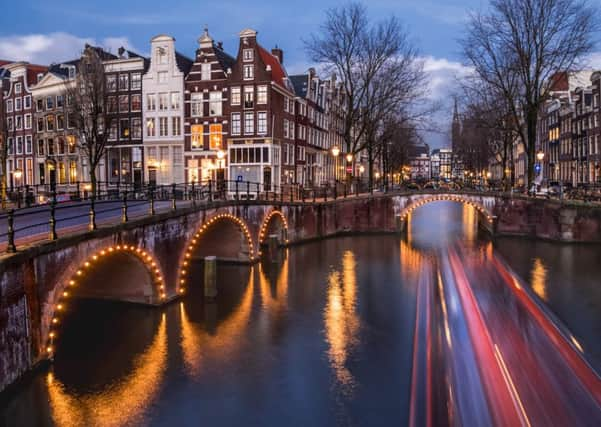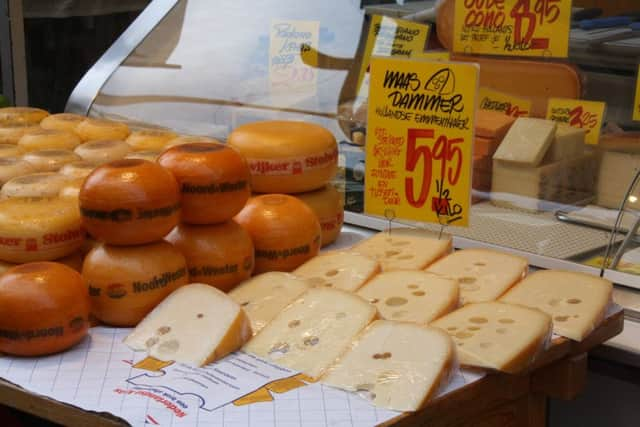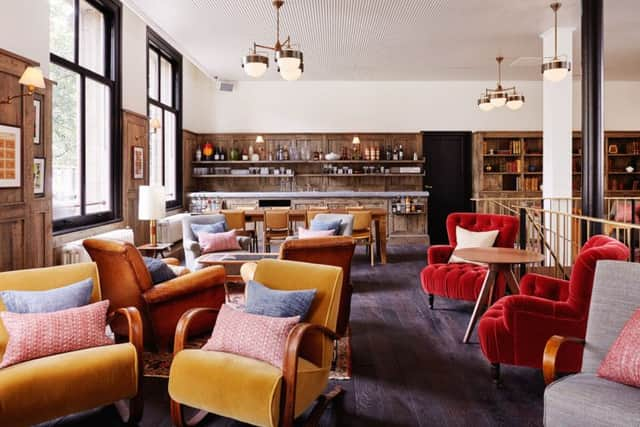Travel: Reflections on vice and virtue in Amsterdam
This article contains affiliate links. We may earn a small commission on items purchased through this article, but that does not affect our editorial judgement.


Leaves swirl above our heads as we cycle beneath the elm trees lining Keizersgracht, gripped by a breeze that sends them spiralling down to the glassy surface of the canal. They join others already adrift on the water, distorting an otherwise perfect reflection of the crooked tenement houses slouching and leaning on their neighbours. The relative tranquillity betrays what is actually Amsterdam’s morning rush hour.
Bikes come and go in a flurry of bells and spokes. At the junction ahead of us, a longer cargo bike bearing toddlers emerges from the thick of the mêlée, streaking down the slope of the humped bridge over the canal and into a sidestreet. We, in comparison, are pedalling at a leisurely pace to our first stop of the day, Europe’s largest outdoor market.
Advertisement
Hide AdWhile Saturday is its busiest day, it is already doing a brisk trade when we arrive for a midweek visit. Some stallholders are still setting up their clothing racks or unloading upcycled furniture for sale, singing along with Motown tunes on the radio as they go. Further along the street, hefty wheels of cheese, split into half and turned outwards to show their small pores, are piled high on top of a fridge counter, itself at bursting point. Handwritten yellow signs with large red prices advertise wares to women pushing bicycles laden with panniers full of fresh produce and flowers.


The Albert Cuyp market became a daily market in 1905 in the city’s shabby chic De Pijp district. Also now known as the Latin Quarter, it is one of the city’s most multicultural districts, home to artists, young couples and minorities from Suriname, the Antilles and Turkey among other places.
• READ MORE: Travel: For whom the bell tolls in Slovenia
The market itself acts as a snapshot of the vibrant community living and thriving here side by side; stalls offering Dutch fare like herring or syrup-filled stroopwafels sit snug alongside veiled women handling hot griddle pans on camping stoves, industriously churning out gözleme flatbreads.
At the far end of the street, we mount our bikes again and set off through the backstreets towards the nearby Rijksmuseum. Reopening to much fanfare in 2013 after a ten-year renovation, the gargantuan museum stores more than a million pieces of Dutch art. If you were to do the national museum justice, you would easily need to set aside hours if not days to fully appreciate the displayed works of the Dutch Masters. If time is tight, there are two one-hour highlight tours a day, which take in treasures such as Vermeer’s The Milkmaid and Rembrandt’s The Night Watch. If culture fatigue hasn’t set in after that, check out the neighbouring Van Gogh museum, housing some of the tortured artist’s finest works.


A breath of fresh air is in order after a few hours wandering gallery spaces so it’s back on our bikes to explore the Grachtengordel – the ring of 17th-century canals that have become the city’s defining feature. It’s here, on leafy Prinsengracht, that you’ll find the Anne Frank House, the museum dedicated to the tragic teenage wartime diarist.
To lift your spirits after a visit to the “secret annexe”, boho Jordaan on the opposite side of the canal is a great spot to stop for lunch, with many pleasing corner cafés.
Advertisement
Hide AdOur hotel is ideally located in the heart of the picturesque canal belt, just five minutes’ walk from Dam square. Opened on Herengracht in 2015, the Hoxton occupies five canal houses, including the former residence of the mayor in the 17th century. A hipster tour de force, the lobby bar and mezzanine coffee den attracts hirsute types working on their MacBooks with a flat white, as well as casual business meetings and lunching friends. Its chilled-out vibe extends to our ridiculously comfortable, vintage-inspired room with views out over the Singel canal.
Given its reputation for having an open-minded approach to drugs and prostitution, it is fair to say the Netherlands attracts visitors with a variety of interests. Cannabis and sex tourism aside, the pull of the grittier side of


• READ MORE: Travel: Coffee and culture in Vienna
Advertisement
Hide AdAmsterdam is alluring – if nothing else, to dispel the clichés of windmills, canals and bicycles.
“The world thinks we’re pretty liberal but we’re not so much these days,” confides Bas, the tie-dye beanie sporting guide on our alternative tour of Amsterdam, as we slope off down Spuistraat towards the epicentre of a counter-culture revolution that swept the city in the 1960s.
Spearheaded by an anarchist-influenced group called the Provos, the movement ultimately sought to make Amsterdam more liveable by addressing social problems and it arguably helped to shape the city as we know and love it today. Among other things, the Provos advocated squatting to ease a chronic housing shortage, ensuring more than 50 per cent of housing in Amsterdam today is cheap social housing, Bas tells us. Even the city’s ubiquitous bicycles – now in such abundance that they outnumber Amsterdammers – only really caught on at the instigation of the Provos and their bike sharing plans.


Cannabis use – another vestige of the movement – continues to be illegal, but police turn a blind eye to it in a nod to tolerance. “As we say here in the Netherlands, ‘we see through our fingers’,” says Bas.
Any tour of the underbelly of the Dutch capital would be remiss in not visiting the infamous red light district. Bas leads us down a fairly innocuous street into what we later learn is the transgender zone, where scantily-clad women lick their lips salaciously at the group from their window perches.
This is a city that will never cease to surprise or inspire. Vice and virtue often go hand in hand, and in Amsterdam you’ll find both are pretty inseparable.
FACT FILE
Advertisement
Hide Ad• KLM (klm.com) flies direct to Amsterdam from Edinburgh, Glasgow, Aberdeen and Inverness with prices from £92 return. Easyjet (easyjet.com) operates daily flights from Edinburgh and six-times weekly flights from Glasgow. Prices start from £30.49 one way.
• ‘Cosy Rooms’ at the Hoxton Amsterdam (thehoxton.com) start at £159 per night.
• Town bike rental with MacBike (macbike.nl) starts from £8.77 for the day, £5.40 for an extra day.